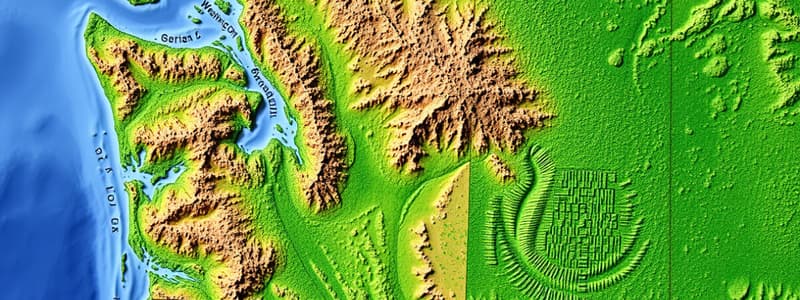Podcast
Questions and Answers
Which of the following are Washington State's five land regions? (Select all that apply)
Which of the following are Washington State's five land regions? (Select all that apply)
- Rocky Mountain Region
- Coastal Range (correct)
- Okanogan Highlands (correct)
- Columbia Plateau (correct)
- Cascade Range (correct)
What are the major industries in the Puget Sound Lowlands?
What are the major industries in the Puget Sound Lowlands?
Aerospace and software
The __________ is the western-most land region of Washington State.
The __________ is the western-most land region of Washington State.
Coastal Range
What two types of farming are common in the Rocky Mountain Region?
What two types of farming are common in the Rocky Mountain Region?
What does the term 'precipitation' refer to?
What does the term 'precipitation' refer to?
What is the definition of 'climate'?
What is the definition of 'climate'?
What is meant by the term 'elevation'?
What is meant by the term 'elevation'?
The land that has water on three sides is known as a __________.
The land that has water on three sides is known as a __________.
The city located in the very center of Washington State is called __________.
The city located in the very center of Washington State is called __________.
The Olympic Mountains are located on the eastern peninsula of Washington State.
The Olympic Mountains are located on the eastern peninsula of Washington State.
Which of the following is true about the semi-arid climate in Washington State?
Which of the following is true about the semi-arid climate in Washington State?
What is true about the west coast marine climate?
What is true about the west coast marine climate?
Study Notes
Washington State's Land Regions
- Washington State is divided into five natural land regions: Coast, Puget Sound Lowlands, Cascade Range, Columbia Plateau, and Okanogan Highlands.
- Each region features distinct geological and climatic characteristics.
Coastal Range
- Located at the west end of Washington State, includes the Olympic Mountains and the Pacific coast.
- Industries such as fishing and timber are prominent, alongside a significant focus on tourism.
- Home to a rain forest ecosystem.
Puget Sound Lowlands
- This region surrounds Puget Sound and sits at sea level with foothills.
- It is the most populated area in Washington State.
- Major industries include aerospace (Boeing) and software (Microsoft).
Cascade Mountain Region
- Acts as a natural divider between Western and Eastern Washington.
- Characterized by rugged terrain and significant elevation changes.
Columbia Plateau
- Comprises a large portion of eastern Washington, with Spokane as its largest city.
- Known for extensive agricultural activities, including crops like wheat, apples, cherries, and grapes.
Okanogan Highlands (Rocky Mountain Region)
- Found in the northeast corner, includes steep foothills of the Rocky Mountains.
- The economy relies on ranching, farming, and mining activities.
Key Geographical Terms
- Precipitation: Water that falls to earth as rain or snow.
- Climate: The average weather conditions over an extended period.
- Elevation: Height of land above sea level.
- Plateau: A raised area of mostly flat land surrounded by mountains.
- Mountain: A prominent high land formation.
- Hills/Highland: Elevated land areas often near mountains.
- Peninsula: A landmass surrounded by water on three sides.
- Island: Land completely surrounded by water.
Notable Cities and Features
- Wenatchee: Centrally located mid-sized city in Washington State.
- Olympic Mountains: A mountain range on the Olympic Peninsula.
- Forks & Sequim: Cities on the Olympic Peninsula located on windward and leeward sides of the Olympic Mountains, respectively.
Climate Types
- Semi-arid climate: Found at elevations below 3,000 ft, characterized by summer temperatures exceeding 100 degrees F and less than 20 inches of annual rainfall.
- West coast marine climate: Mild summers (65-85 degrees F) and winters (35-55 degrees F) with 30-60 inches of annual rainfall.
- Highland climate: Occurs in high mountain areas with short, cool summers and long, cold, wet winters.
- Blue Mountains: Represents both highland and semi-arid climate zones.
Important Water Bodies
- Strait of Juan de Fuca: A significant waterway located to the north of Washington State.
- Columbia River: A major river that flows through the region, essential for agriculture and transport.
Studying That Suits You
Use AI to generate personalized quizzes and flashcards to suit your learning preferences.
Description
Test your knowledge of Washington State's five land regions and their defining characteristics. This quiz covers essential geographic features, including the Coast, Puget Sound Lowlands, and more. Perfect for students or anyone interested in the geography of Washington State.




